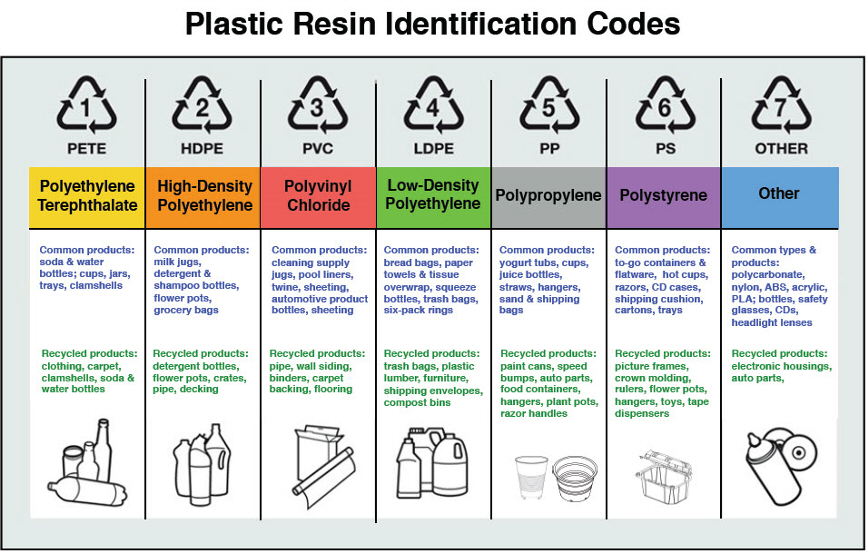Different Type of Plastic and Codes
What we think of as “plastic” covers the wide range of malleable, synthetic compounds we use on a daily basis. In truth, we come into contact with many different plastics, all with varied properties and applications. Most of us would struggle to name even one or two.
Below, we’re looking at some of the different types of plastic.
Polyvinyl Chloride (PVC) (C2H3Cl)n
Melting Point: 100 °C (212 °F) to 260 °C (500 °F)
For all the different types of plastic, PVC is the only one that approaches the status of household name. That’s likely because PVC has, for decades, seen extensive use in commercial and residential properties. It’s a popular option for windows, sidings, and pipes. It’s weatherproof, so it can take the place of traditional construction materials where there’s a desire for both weatherproofing and aesthetics.
PVC remains popular for now, but the jury is out on its future. The toxic nature of PVC is playing a key role in discussions about its future use, as is the difficulty of recycling PVC plastic.
Examples: Plumbing pipes and guttering, electrical wire or cable installation, shower curtains, window frames, and flooring.
Polyethylene Terephthalate (PET) (C10H8O4)n
Melting point: 260 °C
This for of polymer is even more ubiquitous than PVC, but also less well-known.You’ve almost certainly come into contact with PET at some point in your day. It exists in clothing, in plastic bottles, and flexible food packaging. PET can be shaped into fibres and films, which explains its popularity for use in malleable goods. JP Recycling is specialised in recycling mainly PET.
About 25% of PET bottles are recycled in the U.S. with the general idea that bottles made from PET should be recycled and not reused. The recycled PET is crushed into PET flakes and reused to make polyester fiber or new PET bottles.
PET plastic is also recyclable. Its almost universal use in plastic bottles makes PET plastic a popular material of choice for recycling companies.
Examples: Juice or squeeze bottles, Water, fruit juice and soft drink bottles, peanut butter jars, plastic film, and microwaveable packaging.
High-density Polyethylene (HDPE) (CH2-CH2)n
This form of plastic offers a high strength-to-density ratio, which makes it popular in industrial products. But this flexible material is just as popular in consumer goods. HDPE has made popularity gains in recent years as an alternative to the toxicity of PVC goods. Its applications are vast, ranging from bottle caps to food storage containers to plastic bags. Chemical resistant barriers like those used in landfill sites may also be made of HDPE.
However, only 30-35% of these plastics get recycled in the U.S. each year.
Examples: Shampoo containers, milk bottles, detergent bottles, and molded plastic cases.
Low-density Polyethylene (LDPE) –(CH2-CH2)n–
As HDPE’s cousin, LDPE shares many of its traits. However, it’s tensile strength and density are both lower. Moulded objects like containers, tubs, and trays are often composed of LDPE. Manufacturers also use LDPE where flexibility is a key consideration, such as in packaging foam and plastic wraps.
Examples: Garbage bins and bags, outdoor furniture, siding, floor tiles, shower curtains, and clam shell packaging
Polypropylene (PP) (C3H6)n
This form of plastic is the second most-produced commodity plastic after polyethylene. One of PP’s key traits is its resistance to fatigue. This makes it practical for use in any plastics with deformation built into their intended function. Plastic chairs and hinges on flip tops are two such examples.
PP is also heat-resistant, making it practical for use in laboratory and medical equipment. The Many Different Types of Plastic We live in a plastic world, so it’s easy to take the many different types of plastic for granted. Taking the time to learn about these different types can broaden your awareness of just how completely plastic permeates our lives.
Examples: Lunch boxes, take-out food containers, ice cream and yogurt containers, bottle caps, drinking straws, appliances, car bumpers, and plastic pressure pipe systems.
Polystyrene (PS) (C8H8)n
Melting point: ~ 240 °C (464 °F; 513 K)
PS can be recycled and reused but, while many recycling centers can recycle PS, they don’t. This is because the market for PS recycle material is not big enough for them or a local curbside service to get involved in. That has been changing in recent years, but PS still makes up 35% of landfill material in the U.S. Since it can possibly leach carcinogenic styrene into food products, PS should be avoided whenever possible. To do this, try reusable coffee cups, plastic cutlery, and stainless-steel takeaway containers.
Examples: Plastic cutlery, containers, foam cups for hot drinks and packing peanuts, compact disc (CD) and cassette boxes.
Others (HIPS,PES and ABS)
High Impact Polystyrenes (HIPS) – refrigerator liners, vending cups, and food packaging. Polyamides (PA) – fibers, tubing, fishing line, low-strength machine parts such as engine parts or gun frames.
Polyester (PES) – textiles and fibers
Acrylonitrile Butadiene Styrene (ABS) – electronic equipment cases and drainage pipe
Plastic Codes
